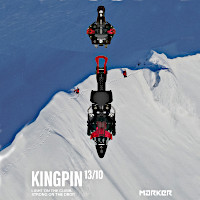


SITE LOGIN
- REVIEWS
- NEWS
- STORE
- ROUTES
- LODGING
-
VIDEOS
- 2022/23 Gear Reviews
- 2021/22 Gear Reviews
- 2020/21 Gear Reviews
- 2019/20 Gear Reviews
- 2018/19 Gear Reviews
- 2017/18 Gear Reviews
- 2016/17 Gear Reviews
- 2015/16 Gear Reviews
- 2014/15 Gear Reviews
- 2013/14 Gear Reviews
- 2012/13 Gear Reviews
- 2011/12 Gear Reviews
- 2020 Outdoor Retailer
- 2019 Outdoor Retailer
- 2018 Outdoor Retailer
- 2017 Outdoor Presscamp
- 2017 Outdoor Retailer
- 2016 Outdoor Presscamp
- 2016 Outdoor Retailer
- 2015 SIA Show
- 2014 Outdoor Retailer
- 2013 SIA Show
- 2012 Outdoor Retailer
- Tips and Tricks
- Backcountry Skiing
- SAFETY
- ABOUT
- REVIEWS
- NEWS
- STORE
- ROUTES
- LODGING
-
VIDEOS
- 2022/23 Gear Reviews
- 2021/22 Gear Reviews
- 2020/21 Gear Reviews
- 2019/20 Gear Reviews
- 2018/19 Gear Reviews
- 2017/18 Gear Reviews
- 2016/17 Gear Reviews
- 2015/16 Gear Reviews
- 2014/15 Gear Reviews
- 2013/14 Gear Reviews
- 2012/13 Gear Reviews
- 2011/12 Gear Reviews
- 2020 Outdoor Retailer
- 2019 Outdoor Retailer
- 2018 Outdoor Retailer
- 2017 Outdoor Presscamp
- 2017 Outdoor Retailer
- 2016 Outdoor Presscamp
- 2016 Outdoor Retailer
- 2015 SIA Show
- 2014 Outdoor Retailer
- 2013 SIA Show
- 2012 Outdoor Retailer
- Tips and Tricks
- Backcountry Skiing
- SAFETY
- ABOUT
TOP VIDEOS
- Home
- »
- REVIEWS
- »
- Summer Gear
- »
- Camping
- »
- Tents
- »
- MSR Hubba Tour 2 Tent
MSR Hubba Tour 2 Tent
Mountain Safety Research (or MSR, for short) has been in the gear-making business for almost 50 years. Founded by an engineer/inventor, the company got its start with “esoteric” items like auto-belay devices and snow flukes.The first MSR tent (called the Mountain Tent) came out in ’73. Because MSR didn’t have a wind tunnel at the time, the tent’s wind resistance was tested by bolting it to a platform mounted on top of a van and speeding down the highway. True story.
We have had the pleasure of testing and reviewing a number or MSR tents over the last decade. If you are curious, take a look at our reviews for the: MSR Carbon Reflex 3 Tent, MSR Elixir 3 Tent or, more recently, the MSR Mutha Hubba NX 3. Note also that, MSR is one of several brands under the Seattle-based Cascade Designs umbrella. Look around on the site for reviews on “sister” brand products from the likes of Sealline and Thermarest.
Hit the arrow in the orange bar below the vid to read the in-depth review.
- SHOW THE REST OF THE REVIEW / PHOTOS / VIDEOS
-
This MSR Tour 2 Tent has some funky features that set it apart from the pack. Let’s dive in…the Tour 2 was used as a home-away-from-home on a six-week WOOFing engagement on a bee farm in Maui. It was a little dusty, if you are wondering why the tent looks less than pristine in some of the accompanying images. It has also served well on several overnight hiking/camping trips here in the Kootenays.
Possible the best aspect of this tent is its large vestibule, seen here in this complete tent shot. Supported by a pole of its own, the vestibule almost doubles the size of covered space and allows for a separate gear and cooking area—ideal in inclement weather. If in a pinch, you can also pack another sleeping body into the vestibule. Note the external pole on the main body of the tent, too. We’ll get into that a little later.
Speaking of the vestibule, here’s a shot from another angle highlighting its voluminous-ness. Plenty of space for gear or two people huddled over a cookstove. Park your footwear here and don’t worry about dirt in the tent itself.
This adjustable webbing across the vestibule entrance allows you to adjust the tension of the vestibule, which you can guy-out independent of the rest of the tent.
This shot shows the backside of the tent, and the second entrance. It’s handy to have two different ways-in—no need to crawl through the big vestibule if you’re ready to hit the sack.
See the external poles (and their intersection point) here? This is one of the features that allows for a painless (and quick) set-up, particularly in the rain. You’ll understand it better looking at the next pic, but the fly and the tent proper are connected. It’s like a single wall tent in that you don’t have to set up the tent and the fly individually—they come together. (Oh, and I told you Maui was dusty….)
Here’s a close-up of one of the many attachment points between tent and fly. You get the benefits of airflow between the two, but without the hassle of setting up two things. A simple design but very secure.
Moving inside, we can see that it’s a “true” two-person tent. Note that also, because there’s so much room in the vestibule, you don’t have to get crowded in the “bedroom” with hiking/biking/whatevering gear.
Another notable aspect is the “kickstand” fly vents allowing for optimal air flow without risking bug attacks or moisture finding its way in.
Colour-coded grommet pole-to-tent attachment program allows for idiot-proof set-up. Even in the dark or rain.
Features:
- Unique Design: Exoskeleton frame and unified rainfly and body keep the tent body dry during setup in foul weather.
- Added Space: Large hooped vestibule provides a dry, protected area for changing clothes, lounging, and storing and prepping gear.
- Livable Features: Two easy-access entrances, multiple gear storage solutions, and an internal glow-in-the-dark zipper.
- Xtreme Shield™ Coating: Ultra-durable coating lasts up to 3 times longer than standard waterproof coatings.
Verdict:
Overall this tent has worked very well. It has been put through the test of intense sun, rain and wind without it showing any signs of wear and tear. It's shape is comfortable and the ability to separate the gear and sleeping areas helps in keeping things clean and organized (two things I sorely needed on my looong trip). Perhaps the biggest test (that it passed, BTW) was my sleeping in it continuously for six weeks.
Its pack-up size worked well for me when on the move as it fit perfectly within my knapsack. As I already stated, this tent is super easy to set up—great in foul weather or after the sun goes down. By having only two support tent poles, and it already being attached to the fly, set-up is lickety split.
Though used mostly for two people, you can pack in three without much trouble. The Tour 2 may be best suited for people keen on fast and easy deployment, as well as a big vestibule for hanging out and storing your kit.
 |
PROS:
|
 |
CONS:
|
SPECS:
Price: $750 CAN
Color: Red/grey
Capacity: 2
Minimum Weight: 2.03kg /4lbs 4oz
Packed Weight: 2.38kg /5lbs 4oz
Floor Area: 2.9sq m / 31sq ft
Vestibule Area: 2.2sq m / 23.5sq ft
Vestibule Volume: 1529l/54cu. ft
Interior Peak Height: .96m / 38in
Packed Size: 53 x 17cm / 21 x 7in
Number of Doors: 2
RATING: 9/10
| Interior Space 2/2 Design 2/2 Features 2/2 Weight 1.5/2 Quality/Price 1.5/2 |
Did we miss something? Are we totally out to lunch? Let us know what you think. People like/dislike gear for different reasons so chime in below and we'll get a well-rounded evaluation. You'll need to login or register before you can comment but it only takes a few seconds, then you're good to go.
Leave a Comment:
Copyright © 2009-25 Backcountry Skiing Canada. All Rights Reserved.








.jpg)
.jpg)
.jpg)
.jpg)
.jpg)
.jpg)
.jpg)
.jpg)
.jpg)
